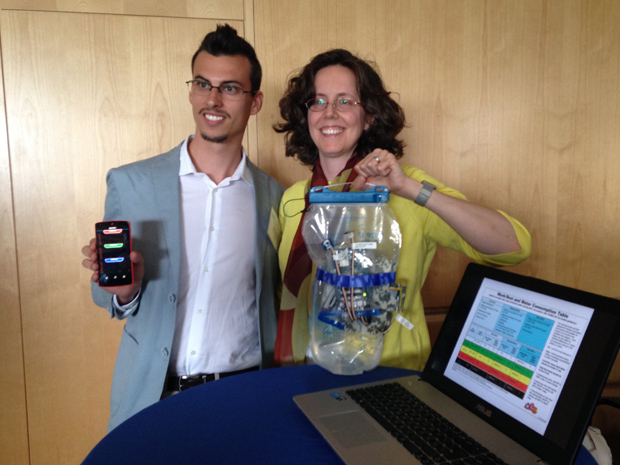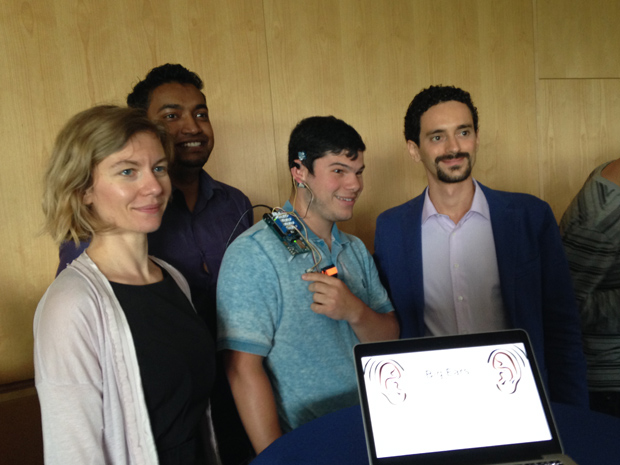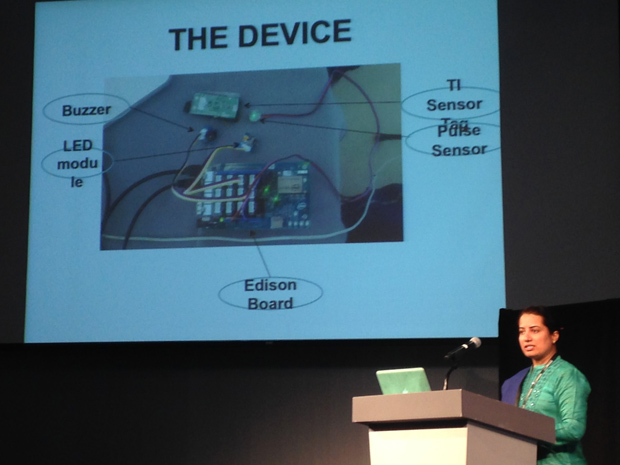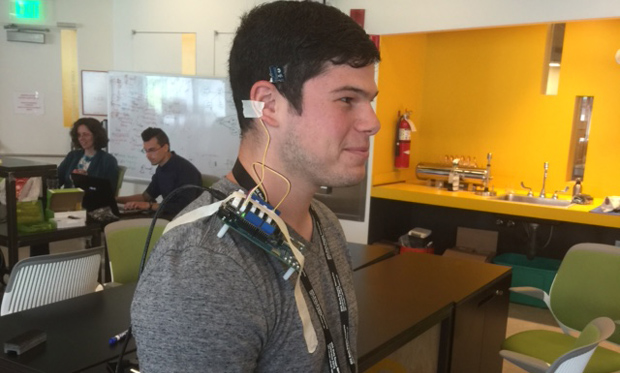Above: Nicholas Constant wearing the Big Ears.
A man with a strange contraption behind his right ear paces a hallway. Wires trail from his ear to a battery pack tucked into his waistband. A woman carefully squeezes a bag filled with water. She watches a series of dots cascade downward on her smartphone. A man looks intently at a computer screen. A green LED connected to a wire emanating from his earlobe blinks away.
This was the scene at the Massachusetts Institute of Technology (MIT) Media Lab in mid June during the Body Sensor Networks Hackathon, a two and a half day hacking tournament sponsored by Intel and the Hamlyn Center at Imperial College London, held in conjunction with IEEE ’s Body Sensor Network (BSN) conference.
For participants in the hackathon, the goal was fairly open ended. “Develop a solution to tackle a healthcare challenge,” directed Benny Lo, lecturer in medical robotics at Imperial College London. Lo organized the hackathon with Gaurav Kaul, a life science software architect for Intel.
But the participants did face some restrictions. The most significant, of course, was time. The hackers spent most of the first day listening to talks about body sensor networks and learning how to use Edison and Galileo, computers the size of a postage stamp and a deck of cards, respectively. (Using one of these hardware platforms was another requirement.) They then had just a day and half to furiously hack away at their chosen healthcare problems, trying to identify solutions using body sensor networks.
What is a Body Sensor Network?
If you’ve ever tracked your steps using a FitBit or monitored your sleep using a smartphone app, you’ve used a body sensor. Put simply, a body sensor is any kind of device that extracts information about a person’s body, whether it’s heart rate, temperature, skin conductance, posture, limb orientation, movement, respiration, or something else. A body sensor network, then, is simply a network of wearable (ideally wireless) sensors that can talk to one another.
While it’s fun to be able to track your body—to know that you’ve moved around enough to burn off that ice cream sundae, or that you’re feeling like a zombie because your child woke you up in the middle of deep sleep—body sensor networks (or BSNs) have much more serious potential. In fact, they could revolutionize healthcare. Right now, there are devices available or in development that can predict when a person is going to get sick before they have noticeable symptoms, monitor how a patient is recuperating following surgery, determine whether a person with Parkinson’s disease needs more medication, and monitor changes in blood pressure. There are also BSN devices designed to monitor symptoms associated with specific conditions such as sleep apnea, diabetes, and asthma.
Challenges
With so many BSN devices already in development, one of the biggest challenges for the hackathon teams was developing an innovative device. But, besides innovation, there are other challenges inherent in trying to use wearable wireless devices to solve healthcare problems. For starters, Guang-Zhong Yang, director of the Hamlyn Center and chair of the hackathon judging panel, told the hacking teams that wireless devices can be battery hogs: up to 75% of the power used by these devices can be from wireless transmission. This is why the Apple Watch can’t be used for sleep monitoring—the battery won’t last the night.
Michael Jackson, general manager of consumer health at Intel and another hackathon judge, broke down some of the other challenges for the crowd: digital distress (doctors can’t handle large amounts of data coming from all of their patients), abandonment (people often stop using body sensor devices once the novelty wears off or because they find them to be uncomfortable), lack of trust (both patients and doctors need to be able to trust that data coming from devices is accurate and secure), lack of interoperability (sensors need to be able to talk to one another), and lack of perceived value (data needs to be interpretable and useful).
A Race Against Time
After being warned of these challenges and given information about the technology they had at their disposal, hackathon participants sat in a circle to begin the process of forming teams. Each person in the diverse group of students and researchers from across the globe took a turn explaining their background and skills. After some discussion, teams formed around different ideas and the hackers were off to the races.
Actually, they were off to Beaver Works, a center that is a joint venture between the MIT Lincoln Laboratory and the School of Engineering. When the teams entered the Beaver Works lab on the MIT campus, they were greeted by bright yellow walls and a large fluorescent beaver sign. The inside looks like it was designed by a scientific-minded beaver or by an engineer with a fondness for wood grain.
Here the teams had space and equipment to begin building their devices. They spent the next day and a half in intense concentration—programming and refining prototypes of their devices. The programming component was crucial since a key part of the hackathon was turning body sensing data into useable information. While everyone would have loved more time, in less than three days’ time, all three teams had mostly functional devices that they could demonstrate for the judges.
Here are some of the innovative developments:
HydroExo

Marathon runners, extreme athletes, and members of the military out in the field know that staying adequately hydrated is key to survival and success. Many of these people take advantage of hydration packs, which allow them to drink through a tube connected to a bag of water in a backpack. While this setup has the advantage of being hands-free, it’s difficult for users to know how much water they are drinking. That’s the problem that HydroExo team members Delsey Sherrill, software engineer and technical team leader at the MIT Lincoln Lab, and Federico Parisi, PhD student at the University of Parma, wanted to solve during the hackathon.
While one of the companies that sells hydration packs, CamelBak, already sells an internal flow meter for this purpose, Sherrill noted that the online reviews for this product showed it had fairly severe limitations. These include problems with accuracy (one reviewer said she started off with 66 ounces of water before embarking on a 17 mile run; the flow meter said she drank 93 ounces by the end of her run), performance (some users didn’t suck hard enough while drinking to engage the sensor), and durability (multiple reviewers mentioned the fragility of the monitor).
And there was another thing. “The amount of water that you should be drinking really depends on how active you are and how hot it is outside, neither of which is taken into account [by the flow meter],” said Sherrill. So Sherrill and Parisi came up with an idea for a different type of hydration sensor.
The prototype of HydroExo that Sherrill and Parisi developed doesn’t measure the flow of the water out of the water bag. Instead, it uses a potentiometer attached to a hinge. This setup measures the deflation of the bag as water is removed. The sensor transmits this information to a smartphone app that the team programmed to show the outside temperature, the user’s activity level (as measured by an accelerometer), and the water level within the hydration bag.
Big Ears

“We want to help people get through rehabilitation by seeing how far along they are,” said Nicholas Constant, a graduate student from the University of Rhode Island. To do this, Constant came up with Big Ears, a wearable BSN device for patients recovering from surgery. Constant was joined on the Big Ears team by Md Shaad Mahmud, a master’s student at the University of Massachusetts Dartmouth, Sara Stančin, a postdoctoral researcher at the University of Ljubljana in Slovenia, and Guglielmo Cola, a postdoctoral researcher at the University of Pisa in Italy.
The team’s goal for Big Ears was to have sensors measure a patient’s gait, heart rate, breathing, temperature, and stress level before surgery—to determine a baseline— and throughout the patient’s recovery. The sensors would be located in a wearable device that sits behind the patient’s ear (hence the name Big Ears), and an LCD screen would show the various parameters. The numbers would glow green if they had returned to baseline and red if they had not.
At the time of the presentations for the hackathon judges, the Big Ears prototype could identify whether a person was walking and if they had a limp, as well as that person’s body temperature. The team said a next generation prototype would include a pulse sensor and a galvanic skin response sensor to measure patient stress.
Queue EZ

In the time immediately following a natural disaster, when hundreds or thousands of people need medical help, it can be difficult for physicians and nurses to determine which patients to care for first.
Queue EZ was designed to help healthcare providers triage patients in a disaster situation. The prototype device contains an ear sensor that monitors a person’s pulse and displays their heart rate with a blinking LED light. It also featured an accelerometer, magnetometer, and gyroscope and was programmed to alarm when the device had been stationary for more than a few seconds. While this part of the device wasn’t wearable in the prototype, the concept is that it would be worn on the neck or the head of each patient. “We’ll know if a particular patient has passed away or gone unconscious,” explained Parmider Kaur, PhD student at Punjab Technical University in India, who came up with the idea for Queue EZ.
“I think the best part of the project is that data can be sent over the network. If you’re in the hospital and have 100 of these devices, you could have a central server that could listen in to all of them,” said Cody Goldberg, an undergraduate student at the University of Rhode Island who was also a member of the team. The team, which also included Krittameth Teachasrisaksakul, a PhD student at Imperial College London, said that a future version of the device could contain sensors that measure glucose and stress levels.
The Winners
Who won? “We had a difficult time reaching a decision,” said Yang. “To me, everyone is a winner since they all accomplished what they wanted to do.” But luckily, because there were so few teams, each team went away with a prize: the Best Application award went to Team Queue EZ, Best Design went to Big Ears, and Most Innovative went to HydroExo. The overall prize went to HydroExo.
The general consensus among the judges and hackathon organizers was that the event was a success. “I was really quite happy that, even though we had a small group of participants, they were able to very quickly build non-trivial prototypes,” said Kaul. “I think this has been a great success, and we hope to continue it in subsequent BSN conferences.”



